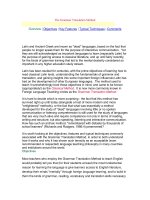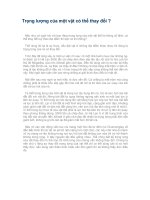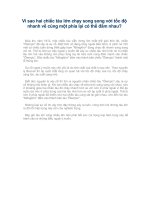The Audiolingual Method.doc
Bạn đang xem bản rút gọn của tài liệu. Xem và tải ngay bản đầy đủ của tài liệu tại đây (37.78 KB, 4 trang )
The Audiolingual Method
Overview | Objectives | Key Features | Typical Techniques | Comments
The next revolution in terms of language teaching methodology coincided with
World War II, when America became aware that it needed people to learn foreign
languages very quickly as part of its overall military operations. The "Army
Method" was suddenly developed to build communicative competence in
translators through very intensive language courses focusing on aural/oral skills.
This in combination with some new ideas about language learning coming from
the disciplines of descriptive linguistics and behavioral psychology went on to
become what is known as the Audiolingual Method (ALM).
Objectives
Just as with the Direct Method that preceded it, the overall goal of the
Audiolingual Method was to create communicative competence in learners.
However, it was thought that the most effective way to do this was for students to
"overlearn" the language being studied through extensive repetition and a variety
of elaborate drills. The idea was to project the linguistic patterns of the language
(based on the studies of structural linguists) into the minds of the learners in a
way that made responses automatic and "habitual". To this end it was held that
the language "habits" of the first language would constantly interfere, and the
only way to overcome ths problem was to facilitate the learning of a new set of
"habits" appropriate linguistically to the language being studied.
Top | Objectives | Key Features | Typical Techniques | Comments
Key Features
Here is a summary of the key features of the Audiolingual Method, taken from
Brown (1994:57) and adapted from Prator and Celce-Murcia (1979).
(1) New material is presented in dialog form.
(2) There is dependence on mimicry, memorization of set phrases, and
overlearning.
(3) Structures are sequenced by means of contrastive analysis and taught one
at a time.
(4) Structural patterns are taught using repetitive drills.
(5) There is little or no grammatical explanation. Grammar is taught by inductive
analogy rather than
deductive explanation.
(6) Vocabulary is strictly limited and learned in context.
(7) There is much use of tapes, language labs, and visual aids.
(8) Great importance is attached to pronunciation.
(9) Very little use of the mother tongue by teachers is permitted.
(10) Successful responses are immediately reinforced.
(11) There is great effort to get students to produce error-free utterances.
(12) There is a tendency to manipulate language and disregard content.
Top | Objectives | Key Features | Typical Techniques | Comments
Typical Techniques
Larsen-Freeman, in her book Techniques and Principles in Language Teaching
(1986:45-47) provides expanded descriptions of some common/typical
techniques closely associated with the Audiolingual Method. The listing here is
in summary form only.
(1) Dialog Memorization
(Students memorize an opening dialog using mimicry and applied role-
playing)
(2) Backward Build-up (Expansion Drill)
(Teacher breaks a line into several parts, students repeat each part starting
at the end of the
sentence and "expanding" backwards through the sentence, adding each
part in sequence)
(3) Repitition Drill
(Students repeat teacher's model as quickly and accurately as possible)
(4) Chain Drill
(Students ask and answer each other one-by-one in a circular chain around
the classroom )
(5) Single Slot Substitution Drill
(Teacher states a line from the dialog, then uses a word or a phrase as a
"cue" that students, when
repeating the line, must substitute into the sentence in the correct place)
(6) Multiple-slot Substitution Drill
(Same as the Single Slot drill, except that there are multiple cues to be
substituted into the line)
(7) Transformation Drill
(Teacher provides a sentence that must be turned into something else, for
example a question to be
turned into a statement, an active sentence to be turned into a negative
statement, etc)
(8) Question-and-answer Drill
(Students should answer or ask questions very quickly)
(9) Use of Minimal Pairs
(Using contrastive analysis, teacher selects a pair of words that sound
identical except for a single
sound that typically poses difficulty for the learners - students are to
pronounce and differentiate the
two words)
(10) Complete the Dialog
(Selected words are erased from a line in the dialog - students must find and
insert)
(11) Grammar Games
(Various games designed to practice a grammar point in context, using lots
of repetition)
Top | Objectives | Key Features | Typical Techniques | Comments
Comments
Just as with the Direct Method, the Audiolingual Method represents a major step
in language teaching methodology that was still aimed squarely at
communicative competence. A teacher that can use the method well will
generally be able to create what appear to be very "productive" students. The
extensive and elaborate drills deisgned to facilitate overlearning and good
"language habit forming" were an innovative addition to the techniques used to
practice language, and many of them are featured as essential parts of
"communicative" methods that followed the Audiolingual Method.
The method's original appearance under the name "The Army Method" is apt,
and from it one ought not to be surprised that the method is all about highly
controlled practice involving extensive repetition aimed at "habit forming". If you
can imagine a squad of new military recruits doing marching drills in the exercise
yard, listening to the terse commands and repeating the movements in various
combinations until they become second nature and do not need to be "thought
about", then you have yourself an effective picture of how the Audiolingual
Method essentially works and creates the desired result. The experts
representing descriptive linguistics at that time can be seen as disseminating the
patterns required to perform the various marching drills piece by piece, and the
behavioral psychologists dictated the various ways for the drills to be repeated in
order to create an effective habit-forming process.
The (however slightly simplified) picture presented above ought to also indicate
to the modern, enlightened and eclectic language teacher the obvious ways in
which the Audiolingual Method falls far short of the overall goal of creating
sustainable long-term communicative competence in language learners. The
linguistic principles upon which the theory was based emphasized surface forms
of language and not the "deep structure". Cognitive principles aimed at
explaining how learners learn and develop independent concepts were to change
considerably in the period following the Audiolingual Method.
Still, there are reasons why the method is still popular, and perhaps even
appropriate in certain educational contexts. In countries where one of the prime
objectives of learning English is to take and achieve successful results in a
variety of tests, and where many learners are not intrinsically motivated to learn
English but do so because they feel they have to, the method is not without
merits. The term "practice makes perfect" was coined at a time when the
concept of practice was synonomous with repetition, and if English is seen as
just "another subject to be learned", then the philosophy of repeating the required
patterns until you get them right without needing to think about them does have a
lot of supporters.









